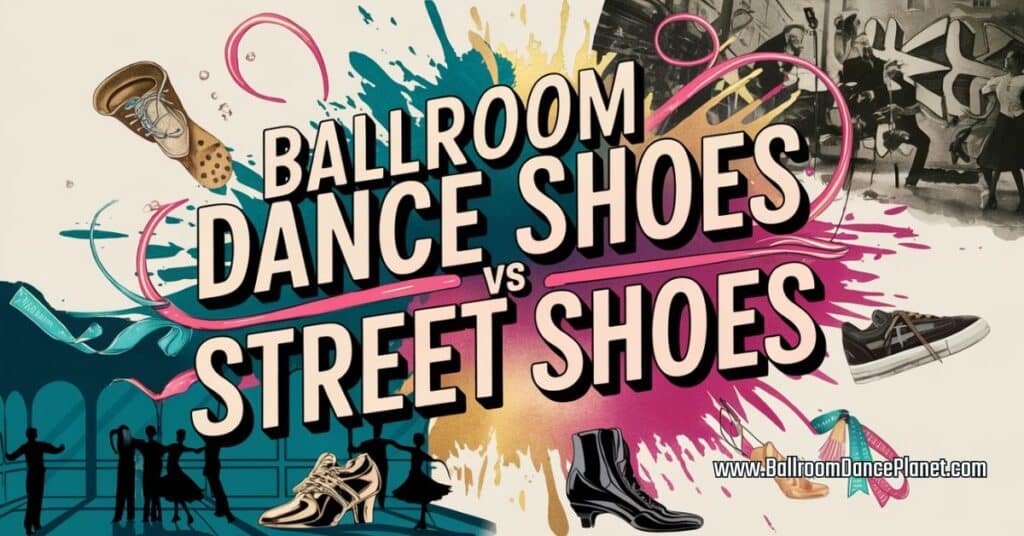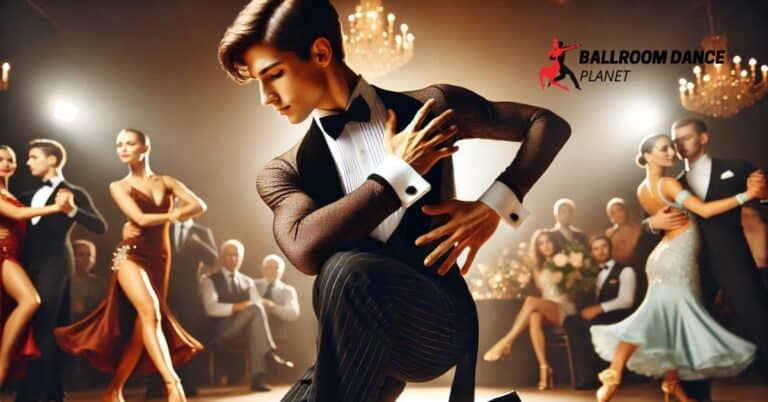Ballroom Dance Shoes Vs Street Shoes – Why It Matters
Have you ever wondered why some dancers glide effortlessly while others struggle? The difference often lies in their shoes. Ballroom dance shoes are crafted for performance, offering lightness and flexibility, while street shoes can weigh you down.
Choosing the right footwear is important for your safety and style on the dance floor. But when is it okay to wear street shoes? Let’s explore the details that make these choices essential for any dancer.

Construction & Design Differences
When you look closely at ballroom dance shoes and street shoes, you’ll see some big differences in how they’re made.
Ballroom shoes are lightweight, crafted from soft materials. This helps them move with your feet. They’ve flexible soles to let you articulate your footwork, and most have suede or leather outsoles that let you glide smoothly.
In contrast, street shoes are heavier and built for durability. With rubber soles, they grip the floor too much. This makes turns and spins tricky.
Plus, they’re often bulky, which can hinder your movement. The snug fit of dance shoes gives you the precision you need, while street shoes can feel clunky and restrictive.
Choosing the right pair is essential for your dancing journey!
Performance on the Dance Floor
The right shoes can really change how you dance. When I wear my ballroom shoes, I feel like I can glide effortlessly. The design helps me pivot smoothly, making it easier to turn without sticking to the floor.
In contrast, street shoes can feel clunky and heavy. They often don’t allow for the graceful movements we need for dancing.
With the right shoes, I can balance better, supporting my posture and footwork. It’s like wearing a magic pair of wings instead of a weighty anchor!
When I dance in the right footwear, the floor becomes my partner, and I can truly express myself. Trust me; your performance will shine with the right choice!
Safety & Injury Prevention
Choosing the right shoes is about more than just style; it can also keep you safe.
If you’ve danced in street shoes, you know the struggle. Those bulky soles can make you trip, leading to ankle twists or knee strain. It’s a dangerous game!
Ballroom dance shoes, on the other hand, hug your feet like a gentle friend. They’ve special support that helps prevent injuries.
With their flexible design, they let you pivot smoothly without worrying about falling.
Style & Aesthetics
While you mightn’t think about it at first, the style of your shoes plays an essential role in ballroom dancing. The elegance of ballroom shoes perfectly complements your dance attire, creating a seamless look.
Their design emphasizes grace, with heels that enhance leg lines and add to your presence on the floor.
On the flip side, street shoes can clash with your outfit. Their bulkiness and casual designs may distract from the overall vibe you want to project.
Imagine wearing sleek, stylish shoes that glide with you, rather than clunky sneakers that remind everyone you’re just practicing.
Choosing the right shoes not only elevates your look but also boosts your confidence, making every dance feel magical.
Longevity & Floor Preservation
When you hit the dance floor, you don’t just impact your performance; you also affect the floor itself.
Using ballroom shoes helps preserve that special flooring. Their suede soles glide smoothly, reducing wear and tear. It’s like using a gentle brush instead of a coarse scrub.
On the other hand, street shoes can bring in dirt and debris. This can scuff the floor, making it unsafe for everyone.
They often have rubber soles, which can stick too much and cause damage over time.
When It’s Okay to Use Street Shoes
Have you ever wondered if there are times when street shoes are acceptable for dancing? In casual social dance settings, it’s often okay to wear street shoes.
If you’re at a laid-back gathering or just practicing with friends, comfort can take priority.
I’ve used dance sneakers or split-sole shoes in these situations, as they provide more flexibility than regular street shoes. They’re designed to allow some movement while still offering support.
However, I’d avoid heavy or rubber-soled shoes for more formal dances or classes. Remember, the goal is to enjoy yourself and feel free to move!
Just try to choose shoes that won’t stick to the floor, so you can glide and pivot smoothly when dancing.
Tips for Choosing the Right Dance Shoe
How can you make sure you pick the right dance shoe for your style? Start by considering the type of dance you’ll be doing.
For ballroom, look for shoes with a flexible sole and suede bottoms. This helps you glide smoothly across the floor.
Next, think about fit. Your shoe should be snug but comfortable, so your foot doesn’t slip around while dancing.
Also, pay attention to heel height. If you’re new, lower heels can offer better balance.
Finally, consider the design—choose a pair you love that matches your style.
Final Thoughts: Invest in Your Dance Journey
Investing in quality ballroom dance shoes can make a big difference in your dance experience.
Think of them as the wings you need to soar across the dance floor. Good shoes provide support, allowing you to twist and turn without fear of injury.
They help you find your rhythm, giving you the confidence to express yourself fully.
Switching to proper dance shoes isn’t just about performance; it’s about embracing your journey.
Whether you’re practicing for a competition or enjoying a social dance, the right shoes elevate your experience.
You deserve to dance without worrying about slips or discomfort. Don’t hesitate—invest in dance shoes and reveal a world of grace and freedom on the floor.


